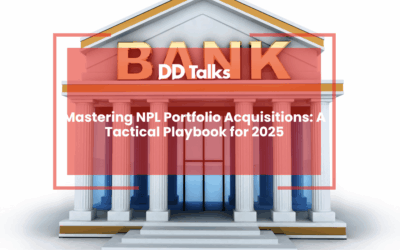Key Takeaways
- Distressed real estate investments typically offer 30-70% discounts below market value, creating substantial equity cushions for investors willing to navigate their complexity.
- Successful NPL investing requires developing robust sourcing channels, with direct bank relationships and connections to loan servicers being particularly valuable.
- Thorough due diligence across legal, financial, physical, and market dimensions is essential, with foreclosure timelines varying significantly across European jurisdictions (4-7 years in Italy vs. 1-2 years in Ireland).
- Effective workout strategies include loan restructuring, foreclosure and property takeover, discounted payoffs, and note sales, with the optimal approach depending on property type and market conditions.
- The COVID-19 pandemic has created a new wave of distressed opportunities, particularly in commercial real estate sectors like hospitality, retail, and office properties.
- Environmental considerations are increasingly important, with green retrofitting of distressed properties becoming a value-add strategy that attracts ESG-focused institutional capital.
Table of Contents
- Understanding Distressed Real Estate and NPL Fundamentals
- How to Identify Profitable NPL Real Estate Opportunities
- Essential Due Diligence for Distressed Property Investments
- Proven NPL Real Estate Workout Strategies for Investors
- Managing Risks in Distressed Property Acquisitions
- The Role of Distressed Real Estate Funds in Today’s Market
- Maximizing Returns: NPL Property Investment Case Studies
- Future Outlook: Emerging Trends in Distressed Real Estate
Understanding Distressed Real Estate and NPL Fundamentals
Distressed real estate investing represents a specialised segment of the property market that focuses on acquiring assets at below-market values due to financial distress. At the core of this investment approach are non-performing loans (NPLs) – loans where borrowers have ceased making scheduled payments for an extended period, typically 90 days or more.
In the European context, NPLs have become particularly significant following the 2008 financial crisis and subsequent economic challenges. Banks across Europe, especially in markets like Italy, Spain, Greece, and Portugal, have accumulated substantial portfolios of non-performing real estate loans that weigh heavily on their balance sheets. These institutions are often motivated to divest these troubled assets, creating opportunities for specialised investors.
The fundamental appeal of distressed real estate investing lies in the potential for significant discounts. Properties linked to NPLs are typically acquired at 30-70% below their intrinsic market value, creating substantial equity cushions for investors. This discount compensates for the additional complexity, time investment, and expertise required to successfully navigate these transactions.
Understanding the NPL lifecycle is crucial for investors. These loans progress through several stages: initial default, workout attempts by the original lender, potential sale to specialised investors, and finally resolution through foreclosure, restructuring, or other means. Each stage presents different entry points and strategies for investors seeking to capitalise on distressed real estate opportunities.
How to Identify Profitable NPL Real Estate Opportunities
Identifying lucrative NPL real estate opportunities requires a systematic approach and deep market knowledge. The most successful distressed property investors develop robust sourcing channels and analytical frameworks to filter through potential deals efficiently.
Direct bank relationships remain one of the most valuable sourcing channels. European banks regularly conduct portfolio sales of non-performing loans, often packaging hundreds or thousands of distressed assets together. Building relationships with bank asset management departments can provide early access to these opportunities before they reach broader markets. Similarly, connections with specialised loan servicers who manage NPL portfolios for financial institutions can yield valuable leads.
Market selection is critical when hunting for NPL opportunities. Investors should focus on regions with high NPL ratios but also positive underlying economic fundamentals. For instance, while southern European markets like Italy and Spain have historically offered abundant NPL inventory, the recovery potential varies significantly between specific regions and cities within these countries.
When evaluating individual opportunities, the loan-to-value (LTV) ratio serves as a crucial metric. Properties with lower LTV ratios generally offer better risk-adjusted returns, as they provide a larger equity cushion. Additionally, understanding the property’s current occupancy status, physical condition, and legal encumbrances is essential for accurate valuation.
Timing also plays a vital role in NPL investing. Counter-cyclical approaches often yield the best results, with optimal entry points occurring during economic downturns when distressed inventory increases and competition decreases. As our previous analysis of NPL portfolios demonstrated, investors who entered southern European markets between 2013-2016 captured some of the highest returns as these economies subsequently recovered.
Essential Due Diligence for Distressed Property Investments
Thorough due diligence is the cornerstone of successful distressed real estate investing, particularly when dealing with NPLs. The complexity of these assets demands a multi-faceted investigation process that goes well beyond standard property assessments.
Legal due diligence forms the foundation of any NPL property evaluation. This includes verifying the enforceability of the loan documents, confirming the validity of security interests, and identifying any potential legal impediments to foreclosure or property transfer. In many European jurisdictions, foreclosure processes can be lengthy and complex, with significant variations between countries. For instance, Italy’s foreclosure timeline averages 4-7 years, while in Ireland, the process typically takes 1-2 years. Understanding these jurisdiction-specific nuances is essential.
Financial due diligence requires a comprehensive analysis of the loan’s payment history, current outstanding balance, and accrued interest or penalties. Investors must also evaluate the borrower’s financial situation to determine the likelihood of potential workout solutions. This assessment should include stress-testing various scenarios to understand how changes in market conditions might affect the investment’s viability.
Physical property assessment is equally critical. This involves professional inspections to identify structural issues, deferred maintenance, environmental concerns, and renovation requirements. Accurately estimating rehabilitation costs is vital for determining the total investment required and the potential return on investment.
Market analysis completes the due diligence process, focusing on local property values, rental rates, occupancy levels, and development trends. This analysis should include both current market conditions and forward-looking projections to ensure the investment thesis remains sound throughout the anticipated holding period.
Proven NPL Real Estate Workout Strategies for Investors
Successful NPL real estate investors employ various workout strategies to extract value from distressed assets. The optimal approach depends on numerous factors, including property type, borrower circumstances, market conditions, and regulatory environment.
Loan restructuring represents one of the most collaborative approaches. This strategy involves modifying loan terms to make them more manageable for the borrower while still providing acceptable returns for the investor. Common restructuring techniques include extending the loan term, reducing the interest rate, forgiving a portion of the principal, or converting debt to equity. This approach works particularly well for commercial properties with viable underlying businesses that are experiencing temporary financial difficulties.
Foreclosure and property takeover is often necessary when borrowers are unwilling or unable to cooperate. This strategy involves legally seizing the property, addressing any deferred maintenance or renovation needs, and then either selling the property for a profit or holding it as a rental. While potentially lucrative, this approach requires navigating complex legal processes that vary significantly across European jurisdictions. For instance, foreclosure in Spain typically takes 2-4 years, while in Germany, the process is considerably more streamlined at 6-12 months.
Discounted payoffs offer another effective strategy. Here, investors negotiate with borrowers to accept a lump-sum payment that’s less than the full loan balance but more than what the investor paid to acquire the NPL. This creates a win-win situation: borrowers clear their debt obligations at a discount, while investors realise quick returns without the complexities of property ownership.
Note sales provide an alternative exit strategy for investors who prefer to avoid property management. After acquiring an NPL and performing initial workout efforts to improve its quality, investors can sell the note to another investor at a premium. This approach allows for shorter holding periods and reduced operational involvement.
Managing Risks in Distressed Property Acquisitions
Distressed real estate investing inherently carries elevated risk profiles compared to traditional property investments. Successful investors implement robust risk management frameworks to mitigate these challenges while preserving upside potential.
Valuation risk represents perhaps the most significant concern in NPL property investments. The distressed nature of these assets often means limited or unreliable information, making accurate valuation challenging. To mitigate this risk, sophisticated investors employ multiple valuation methodologies, including comparable sales analysis, discounted cash flow models, and replacement cost approaches. Additionally, applying conservative assumptions and substantial discount factors provides a margin of safety against valuation errors.
Legal and regulatory risks are particularly pronounced in the European NPL market, where foreclosure laws, tenant protections, and banking regulations vary significantly between countries. For instance, recent regulatory changes in Spain have strengthened consumer protections for residential mortgages, potentially extending workout timelines. Investors can manage these risks by building country-specific expertise, maintaining relationships with local legal advisors, and diversifying across multiple jurisdictions.
Execution risk encompasses the operational challenges of implementing workout strategies. Renovation projects may encounter unexpected issues, tenant negotiations might prove difficult, and market conditions could shift during the holding period. Mitigating execution risk requires detailed planning, contingency budgeting, and maintaining flexibility to adapt strategies as circumstances evolve.
Liquidity risk is inherent in distressed real estate investments, which typically require longer holding periods than traditional property investments. Investors should structure their portfolios to accommodate these extended timeframes, avoiding excessive leverage and maintaining adequate cash reserves to weather market downturns or unexpected expenses.
The Role of Distressed Real Estate Funds in Today’s Market
Distressed real estate funds have emerged as significant players in the European property market, particularly following the 2008 financial crisis and more recently during the economic disruption caused by the COVID-19 pandemic. These specialised investment vehicles pool capital from multiple investors to acquire portfolios of distressed properties and non-performing loans.
The structure of these funds varies considerably, from closed-end private equity vehicles with 5-7 year investment horizons to more flexible open-ended structures. Most operate with target returns of 15-25% IRR, significantly higher than traditional real estate investments to compensate for the additional complexity and risk. Management fee structures typically follow the private equity model, with 1.5-2% annual management fees and 15-20% performance fees above a hurdle rate.
European distressed real estate funds have evolved in their investment focus over time. The first generation of funds, active primarily between 2009-2015, focused heavily on acquiring large NPL portfolios directly from banks under regulatory pressure to reduce their non-performing exposures. These funds, often backed by major international private equity firms like Blackstone, Cerberus, and Lone Star, targeted southern European markets with the highest NPL ratios.
Today’s distressed funds operate in a more mature market with greater competition and sophistication. Many have developed specialised focus areas, such as specific property types (retail, hospitality, office) or geographical niches. Others differentiate through operational expertise, maintaining in-house property management and development capabilities to extract maximum value from acquired assets.
For individual investors, these funds offer access to distressed real estate opportunities without requiring direct operational involvement. However, careful due diligence on fund managers is essential, focusing on their track record through previous market cycles, operational capabilities, and alignment of interests through meaningful general partner co-investment.
Maximizing Returns: NPL Property Investment Case Studies
Examining successful NPL property investments provides valuable insights into effective strategies and potential returns in the European distressed real estate market. These case studies illustrate the diverse approaches investors employ to extract value from non-performing loans.
In Spain’s Costa del Sol region, a distressed fund acquired a portfolio of 35 partially completed residential developments from a regional bank in 2014. The properties had been abandoned during the Spanish real estate crash, with construction halted at various stages of completion. The fund purchased the NPL portfolio at approximately 30% of the original loan value. After completing construction, implementing modern design upgrades, and marketing the properties to both domestic and international buyers, the fund achieved an overall IRR of 22.5% over a five-year holding period. This case demonstrates the value-add potential in completing stalled development projects in markets with strong recovery fundamentals.
In Milan, Italy, an opportunistic investor acquired a non-performing loan secured by a mid-sized office building in 2016. Rather than pursuing immediate foreclosure, the investor negotiated with the borrower to restructure the loan, converting a portion of the debt to an equity stake in the property. The investor then worked with the borrower to implement energy efficiency upgrades and reconfigure the space to accommodate multiple smaller tenants instead of a single occupier. This collaborative approach increased occupancy from 60% to 95% within 18 months, substantially improving cash flow and ultimately delivering a 19% IRR when the stabilised asset was sold to an institutional investor.
In Dublin, Ireland, a specialised NPL investor acquired a portfolio of distressed retail properties in 2015 as the market was beginning to recover from the financial crisis. The investor implemented a dual strategy: for prime locations, they executed light renovations and re-leased the properties at higher rates; for secondary locations, they pursued rezoning and redevelopment into mixed-use or residential properties. This adaptive approach to different asset types within a single portfolio generated returns exceeding 25% IRR, highlighting the importance of flexible workout strategies tailored to each property’s specific circumstances and location.
Future Outlook: Emerging Trends in Distressed Real Estate
The European distressed real estate landscape continues to evolve, shaped by economic cycles, regulatory changes, and structural shifts in property markets. Understanding emerging trends is crucial for investors seeking to position themselves advantageously in this dynamic sector.
The COVID-19 pandemic has created a new wave of distressed opportunities, particularly in the hospitality, retail, and office sectors. Unlike previous cycles where residential properties dominated NPL portfolios, commercial real estate now represents the largest share of distressed assets. European banks are expected to gradually increase their disposal of these non-performing loans as government support measures and forbearance programmes expire. Markets particularly affected include Spain, Italy, and the UK, where the pandemic has accelerated pre-existing structural challenges in retail property.
Regulatory changes continue to reshape the NPL landscape. The European Central Bank’s guidance on NPL management has pressured banks to reduce their non-performing exposures more aggressively. Meanwhile, the EU’s NPL Directive aims to standardise and streamline secondary markets for distressed debt across member states. These regulatory developments are likely to increase NPL transaction volumes while potentially compressing returns due to greater market efficiency and transparency.
Technology is increasingly influencing distressed real estate investing. Advanced data analytics enable more sophisticated identification and valuation of NPL opportunities. Digital platforms are emerging to facilitate NPL transactions, potentially democratising access to this previously institutional-dominated market. Property technology solutions also enhance the operational management of distressed assets, improving efficiency in areas like tenant screening, maintenance coordination, and energy management.
Environmental considerations are becoming increasingly important in distressed property investments. The EU’s focus on sustainability and carbon reduction creates both challenges and opportunities. Distressed properties often require significant upgrades to meet modern energy efficiency standards, increasing rehabilitation costs. However, these improvements can substantially enhance property values and attract ESG-focused institutional capital upon exit. Forward-thinking investors are increasingly incorporating green retrofitting into their distressed property business plans.
Frequently Asked Questions
What are non-performing loans (NPLs) in real estate?
Non-performing loans (NPLs) in real estate are mortgage loans where borrowers have stopped making scheduled payments for at least 90 days. These loans represent distressed debt secured by property assets. Financial institutions typically classify these loans as non-performing when payment delinquency extends beyond this 90-day threshold, indicating significant risk of default.
How do investors make money from distressed real estate?
Investors make money from distressed real estate through several strategies: purchasing properties at significant discounts (30-70% below market value), implementing value-add renovations to increase property worth, restructuring loans for profitable resolutions, foreclosing and repositioning properties for higher returns, or executing discounted payoffs where borrowers settle for less than the full loan amount but more than the investor paid to acquire the NPL.
What are the biggest risks in NPL property investments?
The biggest risks in NPL property investments include: valuation risk (difficulty accurately assessing true property value), legal and regulatory risks (complex foreclosure processes varying by country), execution risk (challenges implementing workout strategies), liquidity risk (extended holding periods), and market timing risk (economic downturns affecting exit strategies). These investments typically require higher returns to compensate for these elevated risk factors.
How long does it take to resolve a distressed property investment?
Resolving a distressed property investment typically takes 2-5 years, though timelines vary significantly based on location and strategy. Foreclosure processes range from 6-12 months in Germany to 4-7 years in Italy. Loan restructuring may resolve in 12-18 months, while property rehabilitation and repositioning generally requires 2-3 years to maximize value. Discounted payoffs can sometimes be executed in under a year for faster returns.
What due diligence is essential before investing in NPL properties?
Essential due diligence for NPL property investments includes: legal verification (confirming loan document enforceability and security interests), financial analysis (reviewing payment history and outstanding balances), physical property assessment (professional inspections for structural issues and renovation requirements), market analysis (evaluating local property values and trends), and jurisdictional research (understanding foreclosure timelines and legal processes specific to the property’s location).
How has COVID-19 affected the distressed real estate market in Europe?
COVID-19 has significantly transformed Europe’s distressed real estate market by creating a new wave of NPLs, particularly in commercial sectors. Hospitality, retail, and office properties now dominate distressed portfolios, unlike previous cycles focused on residential assets. Government support measures temporarily suppressed distress, but as these programs expire, European banks are gradually increasing NPL disposals. The pandemic has also accelerated pre-existing structural challenges in retail property, creating opportunities in adaptive reuse and redevelopment.
What minimum capital is typically required for NPL real estate investing?
NPL real estate investing typically requires substantial capital, with minimum investments starting at €250,000-€500,000 for individual properties and €1-5 million for small portfolios. Institutional NPL portfolio transactions often exceed €50 million. Smaller investors can access this market through distressed real estate funds, which typically require minimum investments of €100,000-€250,000. The capital-intensive nature reflects the complexity, due diligence requirements, and potential renovation costs associated with distressed properties.




0 Comments